Same Scorsese, Ritzier Block : ‘The Age of Innocence’ is just another exploration of the director’s lifelong theme of the individual trapped in society’s grasp
- Share via
Why do so many people think it was such an impossible stretch for Martin Scorsese to make “The Age of Innocence”? Did they think he would turn Edith Wharton’s novel about New York’s old order into a congregation of mooks? Did the cynics anticipate dialogue along the lines of, “You talkin’ to me-- Countess ?” As distant and decorous as some of us find the film, it’s still a movie made by a director who has been obsessed for most of his career with the ways social ritual clamps down on people. The same director who made “Raging Bull” made “Alice Doesn’t Live Here Anymore.” The further back you go with Scorsese’s films, the less perplexing “The Age of Innocence” seems.
I caught my first Scorsese film during spring break of 1972 in a fleabag 42nd Street theater on the bottom half of a double bill with a movie called “1,000 Convicts and a Woman.” The film, “Boxcar Bertha,” was an American International Pictures cheapie starring David Carradine and Barbara Hershey. I went to see it because, through the college movie-nut grapevine, I had heard promising things about Scorsese’s NYU film school student shorts and his 1968 feature, “Who’s That Knocking at My Door?” And so I ascended to the theater’s garbage-y balcony to “discover”--at least for myself--a new genius.
In those days, far more so than today, many of the most promising young directors sprang from schlock. (Today the tendency is to go from schlock to more schlock.) “Boxcar Bertha” was no masterpiece--more like a hillbilly “Bonnie and Clyde” retread--but it was such a smashing piece of direction that I left the theater convinced I had just seen the greatest terrible movie ever made. The kinetic passion of the moviemaking was so far in advance of the threadbare production that the effect was almost parodistic--as if, say, Orson Welles had given his all to a Gene Autry singing-cowboy feature. Here was a director with talent to burn. The fear, of course, was that, given the way Hollywood ruins talent, it would end up burning itself out on mindless programmers.
There’s a story recounted in David Ehrenstein’s book “The Scorsese Picture” about how Scorsese ran “Boxcar Bertha” for his close friend John Cassavetes, who took the director aside afterward and said, “Now that you’ve made a piece of ----, why don’t you make a movie about something you really care about?” Scorsese’s next film, “Mean Streets,” was so deeply personal that it made you feel as if you had tranced right into the director’s own mindscape of guilt and retribution. For film critics like myself who had been following Scorsese even a little bit, “Mean Streets” was a whopping case of promises fulfilled. For emerging filmmakers, it was the key movie of its generation--the one great example of how a feature-length American movie made on a shoestring could nevertheless express a film artist’s deepest torments.
Scorsese’s career from “Mean Streets” to “The Age of Innocence” is emblematic of the ways in which an artist of his generation has twisted and turned in order to hold onto a piece of himself as the industry began an inexorable slide away from the freedoms that gave rise to films like “Mean Streets.” Thematically, he’s moved out of the hothouse and into the parlor but, with the exception of “The Color of Money,” he’s never made a film--not even his great rock documentary “The Last Waltz”--that didn’t seemed ballasted by personal obsession.
Obsessiveness is what’s missing from the new generation of young independent filmmakers--including Quentin Tarantino (“Reservoir Dogs”) and Nick Gomez (“Laws of Gravity”)--who have assumed the impromptu in-your-face attitudes of Scorsese’s early, great work but without his complexity or explosive urgency. Their movies are all attitude. “Mean Streets,” after all, wasn’t only about a bunch of Italian-American guys riffing and slamming each other; “Taxi Driver” wasn’t simply a squalid freak show. These films had a sense of mission that came out of a very real sense of Catholic sin and redemption. (It has been noted perhaps once too often that Scorsese trained for the priesthood.)
The depth of feeling in Scorsese’s strongest films, which also, at its best, include “Raging Bull,” and even in his ardent misfires like “The Last Temptation of Christ” and commercial jobs like “Cape Fear,” is essentially religious (and, often, blackly comic). The hotfoot in his movies comes from hellfire.
Scorsese threw over the academic notion that a filmmaker must somehow “resolve” his conflicts in order to make a successful movie. With Scorsese, the conflict is the movie; the dramas are personal exorcisms that never end. Scorsese has always been one of the least sentimental of filmmakers: he doesn’t deliquesce his raging bulls into pools of pathos. His movies, good and bad, are chocked with unremitting obsessives: Johnny Boy in “Mean Streets,” Travis Bickle in “Taxi Driver,” Jake La Motta in “Raging Bull,” Rupert Pupkin in “King of Comedy,” Jesus in “The Last Temptation of Christ,” Tommy in “GoodFellas,” Cady in “Cape Fear.”
These avengers are there to shake out the demons from the film’s “good” characters. Harvey Keitel’s Charlie in “Mean Streets” says of De Niro’s crazy Johnny Boy, “Who’ll help him if I don’t?” But it is Charlie and not Johnny Boy who holds his hand over a flame to experience the torments of damnation. Johnny Boy is Charlie demonized, and Charlie is drawn to him as he is drawn to the flame.
De Niro is at the center of so many of Scorsese’s films because he is a genius at monomania--and monomania is the engine that, for good or ill, keeps these films on track. Scorsese needs these maniacs to balance out (and tempt) the people who are struggling to do right by their lives. (Every Passion Play needs its devil.) De Niro is singular among great actors in that, unlike, say Brando or Pacino, his characters don’t have a whole lot of layering.
With Brando, we are always aware of the emotional possibilities open to his characters. With De Niro, those possibilities have long ago been shut down --if they ever existed. What De Niro does at his best, as in “Taxi Driver,” is to get so deeply into the shadings of a single emotion--a single fixation-- that the chasm he opens up is like a highway to hell.
Obsessiveness can run dry, though. “Raging Bull” tapped out the vein. There was no further place for Scorsese to go into unyieldingness after Jake La Motta martyred himself in a wash of blood and battered his brains to the strains of Mascagni’s “Cavalleria Rusticana.” What seemed resonant and trance-like in that film, or in “Taxi Driver,” seemed merely spooky and one-note in a film like “King of Comedy” and “Cape Fear” or “GoodFellas.”
There was a pro forma quality to the horrors of “Cape Fear.” De Niro and Scorsese worked up a scare but they didn’t yank anything new out of themselves. “GoodFellas” skimmed the surface of its horrors, too, zipping from one grotesque burlesque to the next, featuring at its core a blank--Ray Liotta’s Henry Hill--surrounded by a bevy of other blanks. It was a zombietown gangster film with a chuckling facetious tone, but its cartoonishness made it scrumptious for audiences who prefer their monomanias lo-cal.
Scorsese must have recognized the need to move away from this torched terrain and renew himself, and that is perhaps why he alighted on “Age of Innocence.” It brings him into the comforts of classicism, but it retains his lifelong theme of the individual crossed with society. He’s trying to feel his way into society’s upper reaches instead of its lower depths but the principle remains the same. What thematic difference is there, finally, between the scene in “GoodFellas” where Henry Hill asks a favor of the local capo , and the scene in “Age of Innocence” where the well-born Archers ask the blueblood van der Leydens to intercede in the matter of their cousin the countess?
Daniel Day-Lewis’ Newland Archer isn’t the usual Scorsese protagonist, though. He’s a reactive hero: a man of tentativeness and breeding. And he is perhaps a reason “The Age of Innocence” feels a little hollow at its core. Newland is a bit of an asparagus; we don’t feel his desperation at being closed off from his beloved and locked into the horrors of a predictable life.
Instead, the movie’s center shifts to the countess because, as Michelle Pfeiffer plays her, she has the woebegone gravity of someone haunted by the predicaments of her class. Her beauty is a bit blurry and wan, as if she were already dissolving into a memento mori before her lover’s eyes. Pfeiffer perfectly captures what Edith Wharton described as “Madame Olenska’s mysterious faculty of suggesting tragic and moving possibilities outside the daily run of experience.”
Scorsese, along with Francis Coppola, George Lucas, Steven Spielberg, Brian DePalma and many others, was in the vanguard of the first generation of American filmmakers to come out of the film schools. They took up film not only as a means to “personal” expression but also as a way of commenting on--and thereby making their own--the films that formed them. They regarded the movies of their childhood and adolescence as a shared mythology. The references in their movies to other movies was as personal a gesture as the references to their own lives.
And yet the films like “Mean Streets” and “Taxi Driver” that made Scorsese’s reputation implicitly rejected much of his cherished Hollywood legacy. They came out of a different, more underground tradition, bounded by the work of directors like Cassavetes and Shirley Clarke. He could follow up “Mean Streets” with a shaggy, crowd-pleasing romantic comedy like “Alice Doesn’t Live Here Anymore,” as if to show his affection for the old studio tradition. But Scorsese’s rejection/embrace of Hollywood came through most pointedly in his big ‘40s musical “New York, New York,” which was as elaborately staged as anything by Vincente Minnelli but as dark, in places, as anything in “Taxi Driver.” Flawed, harrowing, it was an anti-musical that revealed Scorsese’s need to go beyond Hollywood’s happy-ending artifices even as he clasped them.
And wasn’t “The Last Temptation of Christ” an anti-biblical epic? And wasn’t “Raging Bull” a glove in the face of every other Hollywood boxing movie? As Scorsese’s career has developed, his movie sources have been increasingly aboveground--he’s gone from Cassavetes to DeMille, so to speak. But the subversive intent has always been there. What’s different about “Age of Innocence” is that, of his films, it’s the least subversive of its sources. It summons up Visconti’s “The Leopard” and Welles’ “The Magnificent Ambersons” in tribute, not contention.
Is it unfair to ask for more steam heat from Scorsese? Classicism is perhaps best left to those, like Merchant-Ivory, who share its temperament. There’s a studied quality to “Age of Innocence”--it’s not an intuitive piece of work. (And it’s not as deeply funny as Wharton, either.) But it’s an honorable piece of work: an attempt by one of our finest filmmakers to extend his sensibility into the sorrowful reaches of classic, high-born drama. In a modern Hollywood preoccupied with mindless melodrama, this sort of film may be one of the few ways in which audiences can be made to feel they have experienced “art.” What Scorsese has demonstrated throughout his career is that there are other, more challenging and vehement ways to experience art.
More to Read
Only good movies
Get the Indie Focus newsletter, Mark Olsen's weekly guide to the world of cinema.
You may occasionally receive promotional content from the Los Angeles Times.










